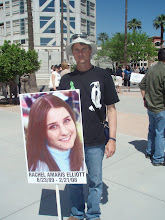I need someone to explain to me why the establishments which profit from the irresponsible sale of alcoholic beverages to their patrons bear no liability for the devastation that results. I guess the answer is obvious. Sadly, in a contest between profit and propriety, money wins. As long as there is a buck to be made, the slaughter of innocents will continue. The profiteers will pour another round, turn a blind and jaundiced eye, and wash their hands of the deadly cocktail they have mixed. As far as I am concerned, they are accessories to murder. The drunk is intoxicated and impaired. Those who continue to sell alcohol to their drunk customers make a coldly calculated choice of money over life.
Why are the alcohol industry and its pushers treated differently than, say, the tobacco industry? Statistics indicate that the public pays a high price for maintaining the status quo. We the people effectively subsidize the damage inflicted by the abusers of alcohol to the tune of $1.00 per drink sold in the U.S. Should I be forced to pay for the murder of my own daughter so that a senseless drunk can have the privilege of buying cheap drinks at a seedy bar that has no higher accounting than their own bottom line? The real bottom line is too high to tally, and one that is carefully hidden from public view. 11,000 + casualties and billions of dollars in damages per year are acceptable losses as long as the liquor - and the money - continues to flow.
I continue to read about it everyday in the paper, and it breaks my heart. More than a year and a half after Rachel was killed by a drunk driver: Nothing's changed...
http://news.yahoo.com/s/ap/20090901/ap_on_he_me/us_med_drunken_driving
ATLANTA – One in 10 binge drinkers got behind the wheel the last time they drank heavily. And half of those drivers left from a bar, restaurant or nightclub after downing five or more drinks, a new study has found.
The study is being called the first to try to measure the likelihood someone will drive after binge drinking. It suggests a need for stepped-up efforts to prevent bars and restaurants from serving people after they're intoxicated, according to its authors at the Centers for Disease Control and Prevention.
The researchers focused on 14,000 "binge drinkers " — people who said that at least once month that they had five or more drinks on a single occasion. About 12 percent said they had gone driving within two hours of their last bout of heavy drinking.
Of those drivers, more than half took the wheel after drinking in a bar, restaurant or other licensed establishment. And half of the drivers who left an establishment said they had seven or more drinks; a quarter said they'd had at least 10.
Some people can handle alcohol better than others, and eating food or drinking over several hours can soften alcohol's impact. But clearly 10 drinks is a lot, said James Fell of the Pacific Institute for Research and Evaluation, a national research organization focused on alcohol policy.
"Almost everybody's going to be intoxicated after 10 drinks," said Fell, who was not involved in the study.
Binge drinking is a main factor behind the more than 11,000 deaths annually from alcohol-related motor vehicle crashes, said Dr. Timothy Naimi, an epidemiologist with the CDC's alcohol program. He led the study, which was released Tuesday and will be in the October issue of the American Journal of Preventive Medicine.
Nearly every state has a law that in theory prohibits licensed establishments from selling alcohol to drunk patrons. But most states don't have enough enforcement personnel to stop in on bars and watch for over-serving of customers.
"These are among the most disregarded laws in the country," Naimi said.
Without policing, there's little incentive for bars, clubs and restaurants to discourage drinking. Tips depend on keeping patrons happy and buying, noted Jim Mosher, a Washington, D.C.-based legal researcher and consultant on alcohol issues.
The American Beverage Institute, a restaurant trade association, had no immediate comment on the study Monday. The organization's Web site promotes efforts to apprehend and penalize drunk drivers, but also notes voluntary server training and other efforts by restaurants to discourage drunk driving.
The CDC study was based on a telephone survey done in 2003 and 2004, and some things have changed since then. Drunk driving fatalities have decreased, dropping nearly 10 percent from 2007 to 2008, according to the National Highway Traffic Safety Administration. There have also been a variety of efforts to reduce drunk driving including court-mandated devices that prevent a car from starting if a driver is drunk.
But most efforts focus on punishing the driver and not preventing drunk driving by focusing on those who enable it.
"The drinking location is really important," said Naimi. "We're trusting these licensed establishments to serve responsibly, and more than half of the intoxicated people who drive have been drinking in these places."
A follow-up survey in 2008 found the situation hadn't changed, he added. Those results haven't yet been released.
